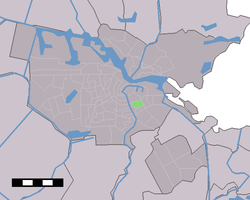Oosterparkbuurt
| province |
|
| local community |
|
|
Area - land - water |
0.75 km 2 0.72 km 2 0.03 km 2 |
| Residents | 10,905 (Jan. 1, 2017) |
| Coordinates | 52 ° 22 ′ N , 4 ° 55 ′ E |
| Important traffic route |
|
| prefix | 020 |
| Postcodes | 1091-1092 |
| Location of the Oosterparkbuurt neighborhood in Amsterdam | |
The Oosterparkbuurt is a multicultural residential area in the Amsterdam-Oost district ( province of North Holland ), which was built towards the end of the 19th century and had 10,905 inhabitants in 2017.
history
In 1881, the designation of building land began in what is now the district and, from 1886, the Oosterpark was created. The final design of the Oosterpark came from the landscape architect Leonard Anthony Springer (1855–1940). The Royal Tropical Institute ( Koninklijke Instituut voor de Tropen ), formerly known as the “Koloniaal Instituut”, has been located on the border of the Oosterpark since 1926 .
The Oosterparkviertel is divided into Oosterpark-West and Oosterpark-Oost. It is a multicultural residential area with two shopping centers in the Linnaeusstraat and the Beukenplein , two primary schools and a community center for the residents, a nursing home and two playgrounds. The Kastanjeplein , Eikenplein and Iepenplein squares in the quarter were thoroughly renovated after 2006.
The quarter is bordered by the Wibautstraat , the Mauritskade and the Linnaeusstraat as well as the Amsterdam - Utrecht railway line.

In 1884 the first " horse tram " ( Paardentram ) drove to Oosterpark, in 1903 the first electric Amsterdam tram line 9 came into the district and in 1906 the second connection of local public transport with line 11 was created. This was replaced by line 3 in 1945. In the course of urban redevelopment in the 1970s, numerous older houses were demolished and new buildings with larger apartments were built.
In 2008 the “Rode Loper Festival” took place for the tenth time with a street market, performances, music and dance, film screening and activities for children. The museums NiNsee , Uitvaartmuseum , Tropenmuseum and Persmuseum were accessible free of charge. Music and poetry were offered in the community center “t Blijvertje” and the “Historisch Adviesbureau 30-45”, which specializes in historical advice and information on the years 1900 to 1945, organized a nostalgic exhibition with music, people dressed in historical clothing . An apartment in the Oosterparkbuurt was furnished in the style from before 1945.
further reading
Ton Heijdra, Stomweg gelukkig in Amsterdam-Oost. The divorced van Dapperbuurt, "Oosterparkbuurt", Weesperzijdestrook en Transvaalbuurt . Uitgeverij René de Milliano, Alkmaar 1996. ISBN 90-72810-16-3 .
Web links
- Information for the residents of the Oosterparkbuurt district Online (Dutch)
Individual evidence
- ↑ a b Kerncijfers wijken en buurten 2017 Centraal Bureau voor de Statistiek , accessed on April 26, 2018 (Dutch)
- ^ Rode Loper Festival . Dutch, accessed February 15, 2011
